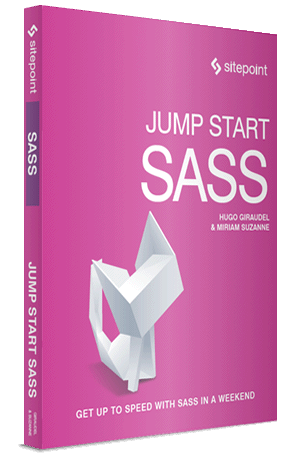Hey everybody,
I have a huge announcement to make! Just a few days ago, we added the final touches to our latest masterpiece in the Jump Start collection: Jump Start Sass.
I have been working closely with SitePoint for the past months to write a book on Sass dedicated to people wanting to learn more about the preprocessor, its language and how to use it in daily projects to help boost productivity.
Miriam Suzanne (the author of Susy and the True testing framework) and I have joined forces to offer you a result that is not only comprehensive, but also simple and accessible. Basically, it’s 157 pages of awesomeness (in my un-biased opinion!).
What’s in there?
Here is the table of contents and a few words on each chapter to get you hungry:
- Foreword (by no other than Chris Eppstein)
- Hello World — An introduction to Sass in modern front-end development, its history, its syntaxes (Sass and SCSS) as well as its competitors (LESS, Stylus and PostCSS).
- Getting Started — A short explanation on how to install Sass binaries (both the Ruby gem and node-sass) and how to use them to compile Sass stylesheets to CSS.
- Variables — An extensive chapter on variables, how they work, how to use them, when and why, closed with a comparison with CSS Custom Properties.
- Functions & Mixins — A chapter dedicated to mastering functions and mixins to start building small systems.
- Loops & Conditions — A concise explanation of how logical structures work in Sass, mainly loops and conditions statements, and how to use them to build powerful mixins.
- Nesting — A reminder on the nesting feature, mostly focused on selector nesting, providing helpful tips to avoid being lost in the dreaded horizontal pyramid of selectors.
- Extend — A solid introduction to the
@extenddirective and how to avoid bloated output when using it. - Warnings & Errors — An introduction to the ability to emit warnings and throw errors directly from within stylesheets, as well as why and when doing so makes sense.
- Architecture — A massive chapter on different approaches to Sass-powered project architecture, including OOCSS, ITCSS, SMACSS and more.
- Ecosystem — The final chapter introduces you to the Sass ecosystem, its main toolkits, libraries and frameworks such as Bourbon, Susy, Accoutrement, SassDoc, Sass-Guidelines, Modular Scale, SCSS-lint and many many more.
That covers quite a lot, doesn’t it?
Who is this book for?
As you can guess from the table of contents, this book is essentially targeted to newcomers and beginners, all the way up to the intermediate level. This is part of SitePoint’s Jump Start series, so it’s not aimed at advanced Sass users.
However if you feel a bit short on Sass, are not too sure about how to tackle project architecture or simply find yourself in need of a refresher, you’ll be pleased. I promise that.
On top of this book, I recommend you bookmark the SitePoint Sass Reference as a quick reference for features tackled in this book, as well as Sass Guidelines to push the quality of your Sass code to the next level.
It’s available on SitePoint Premium, SitePoint’s subscription service, or you can order a print or ebook version via O’Reilly.
Alright. Go read it now, and let us know what you think!
Non-binary trans accessibility & diversity advocate, frontend developer, author. Real life cat. She/they.



